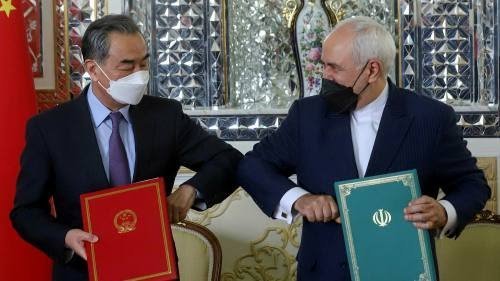Receiving little notice or discussion in the mainstream press, Iran and China have just signed a comprehensive strategic agreement, stretching over 25 years, to the tune of upwards of $500 billion. In other words, this is a permanent agreement, if one thinks in the long term, as do most Asian nations. The agreement will be a boon to both Iran and China – a win-win agreement for sure. It will also mark some serious re-thinking of strategies in the West relative to Asia and especially to the Middle East, now known as West Asia. The Beltway is not happy about the agreement, for obvious reasons given their current animosity to both Iran and to China. This agreement bears a closer look, as it marks the start of big changes to come in the power base in West Asia and American influence therein.
The signing of the agreement, called “The Comprehensive Strategic Partnership between I.R. Iran, P.R. China” (CSPIC), took place in Tehran at 14:43 Iran daylight time (UTC -4:30 minutes) on Saturday, 27 March 2021. The chart is below (bigger)
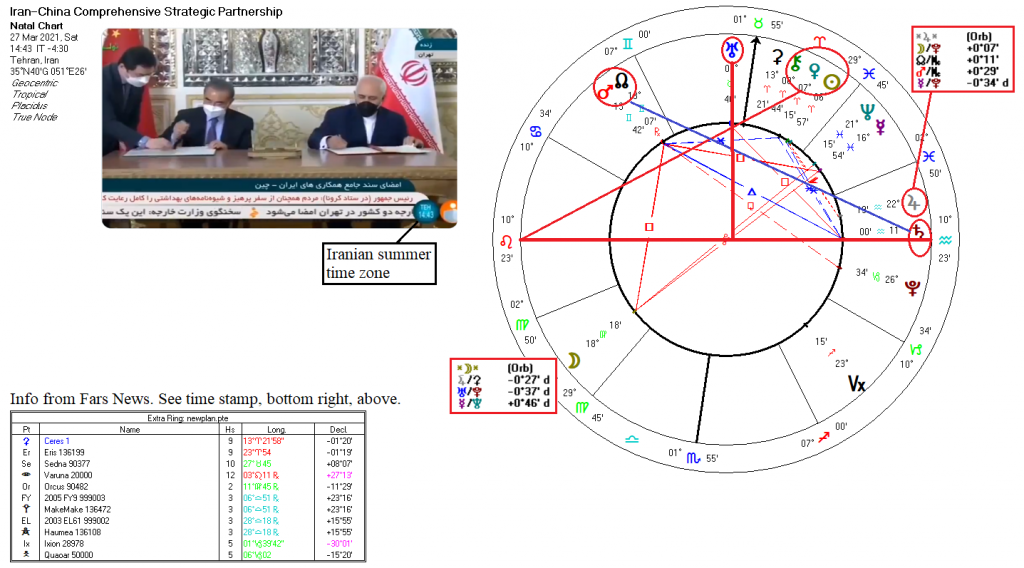
The full text of the Partnership reveals the following points:
- They (China and Iran) recognize each other as important strategic partners, “…and thus designate the expansion of bilateral relations as a priority of their respective foreign policies.”
- Have established, “…a mechanism of annual meetings between their Ministers of Foreign Affairs as well as periodic consultation meetings between their relevant regional Deputy-Ministers of Foreign Affairs.”
- Expanding relations at all levels of governments in order to exchange views and ideas and strengthen interactions
- Emphasized the roles of legislative bodies on both sides to develop and enhance ties between the two nations
- Emphasized “…independence, national sovereignty, and territorial integrity. The Iranian side continues its strong commitment to the One-China policy. The Chinese side supports the Iranian side’s “Development Plan” as well as increasing Iran’s role in regional and international affairs.” That is an important point.
- Stressed “…the complementariness of their economic potentials as well as existence of numerous areas of joint cooperation such as energy, infrastructure, industry and technology, both sides agree to put consultations and discussions aimed at concluding a bilateral 25-year Comprehensive Cooperation Agreement on their agendas.”
- The Iranian side welcomes “the Silk Road Economic Belt and the 21st Century Maritime Silk Road” initiative. This is another big point, perhaps one of the biggest.
- And finally, both sides will work to “…promote tangible cooperation in the areas of economy, banking, mutual investment, financing, mining, transportation, communications, space, manufacturing industries, developing of ports, upgrading and expansion of railway networks, express railway systems, agriculture, water resources, protection of environment, food security, fighting desertification, water desalination, use of nuclear energy for peaceful purposes and renewable energies, based on the bilateral “MOU on Strengthening of Investment Cooperation” and cooperating in the exchange of know-how and technology as well as in human resource training.” That’s a mouthful, and covers all areas of mutual cooperation, across all technical fields. The bolded points are quite significant on their own.
There is more, but these cover the main outline. The last bullet point is the most significant of all the above, and alludes to what could amount to an explosion of technological innovation across Central Asia, as well as a fundamental change in financing and currency exchange, which will accelerate the development of tech infrastructure there. Unless we know something about technical training in Iran and China, what was just stated would seem impossible to some readers, but this development should have the strategic planners in the West very worried. Here is why:
Even by 2017 measures, Russia, China and Iran, and in that order, produce the highest number of STEM (science, technical, engineering and mathematics) graduates per capita than any other nation, at least double that of the United States, Japan and India. Is it any wonder the three leaders in STEM have done so well technologically and have surpassed the West in so many areas? American educational standards in particular have fallen steadily behind. And it is worth noting many of the STEM graduates in the US are…wait for it…Asian-American. I attended a class in electrical engineering in the early ‘80s that was full of Iranian students, and they were very good students. They place a high value on such education, as do the Russians and Chinese. The US used to have a robust STEM curriculum in its heyday, but seems to have lost interest in it. And now math courses in the US are being targeted for being ‘racist’ (!??).
The entire document linked above is well worth reading. With all the above in mind, what does the chart for the agreement show? To start, an astrologer must have set up this chart. The immediate stand-outs are the Sun/Venus conjunction in the 9th house (foreign trade and ideals), showing the friendship the agreement represents, trine to the Leo Ascendant. It is a bold and pioneering (Leo and Aries, resp.) agreement, supported by the friendship between the nations. And there is great wealth, built steadily over time, shown by the Mars/Saturn trine, one of the premier ‘wealth aspects’. That trine is also exemplary of strategic planning.
Mars is conjunct the North Node, indicating vigorous energy poured into the relationship, carefully planned, shown by the nodal trine to Saturn. Saturn is on the Descendant of the chart, showing stability in the agreement in this case, rather than restriction. From another view, the Saturn placement also shows the fated or destined nature of the partnership. Both sides recognize their mutual need and benefit in the present world situation, being pressured as they are by belligerent nations.
Ceres, representing nurturing and supply of ‘food’ (resources), sits at the midpoint of the Mars/Saturn trine, giving us the following midpoint: Ceres=Mars/Saturn. This brings up an interesting side to what has otherwise been called the ‘death axis’ (Mars/Saturn midpoint) in previous posts on this site. The trine in this case indicates a more positive expression of that midpoint axis: “Manual laborers, miners. – Energetic people who are able to overcome the greatest difficulties.” Few nations are experiencing the sort of difficulties being endured by Iran. And China faces its own great difficulties, not the least of which are its need for resources and its aging large population.
The midpoints in the chart are a study by themselves and support the combinations just mentioned on the whole, but there is not the space here to go into them. For an example, Jupiter is not in a major aspect with the other planets, but it is at several important midpoints, as shown on the chart, all of which go toward bolstering the overall picture. The same is true of the Moon, the midpoints to the Moon being of particular interest here.
The Moon is in the 2nd house of the chart, relating to finances in both nations. But there is one item in the agreement that is especially concerning to the US, and that is the ability of Iran and China to trade in their own currencies, bypassing the SWIFT system. In other words, sanctions will not affect Iran-China cross-border trade. That single factor will be a boon to Iran and will mark something else as well – the beginning of the end of the ability of the US and Europeans to use sanctions as a weapon against other nations. It is a revolutionary agreement and event, as shown by the midpoint, Moon=Uranus/Pluto: “Intuition, restlessness, daring and audaciousness, ambition, determination. – Bringing about changes by force.” Needless to say, the Global South will be watching developments between Iran and China very closely. So will the West.
However, a chart cannot be judged simply in its own merits when it comes to agreements. All nations or parties to an agreement must be considered in relation to the agreement chart as well. We start with the synastry between Iran and the CSPIC. The bi-wheel is below (bigger):
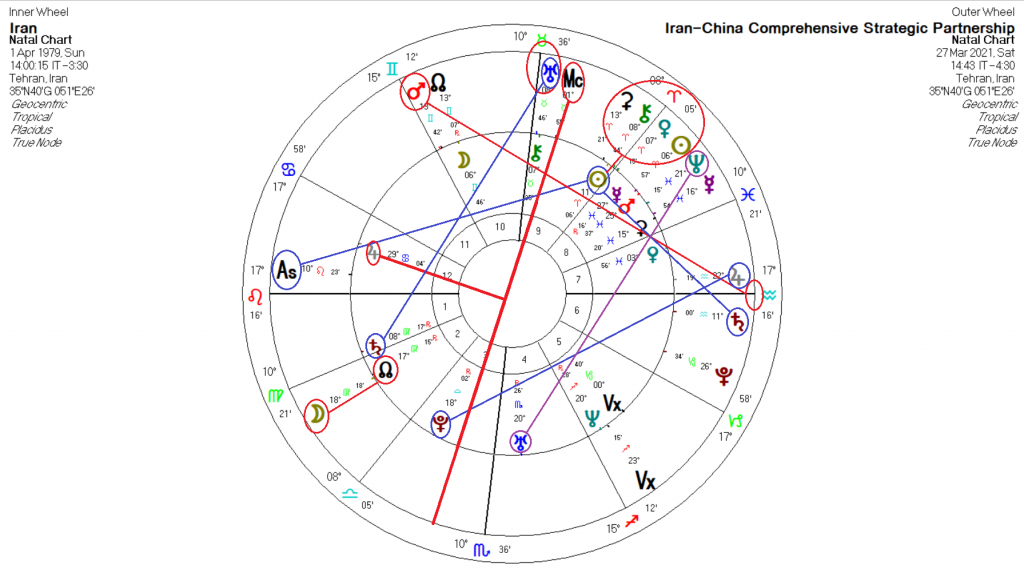
Just to highlight a few points, the Ascendant of the agreement trines Iran’s Sun, with an almost exact sextile between the agreement Saturn and Iran’s Sun. The purpose of the agreement is to bring opportunity and stability to Iran. With the agreement Saturn in Iran’s 6th house, it is also a security agreement (6th house ruling the military and services). That is further bolstered by the agreement Mars trine Iran’s Descendant.
The agreement Meridian axis squares Iran’s Jupiter, with Iran’s Pluto trine the agreement Jupiter, marking the agreement as one that will expand resources and infrastructure in Iran, with a particular focus on Iran’s underground resources (Pluto). The agreement Sun/Venus/Chiron conjunction is conjunct Iran’s Sun, so there is parity between Iran’s ambitions and the agreement’s terms. There is more, but perhaps the preceding illustrates the point – this agreement fits very well with Iran’s objectives.
Next we turn to the agreement’s synastry with China. The bi-wheel is below (bigger):
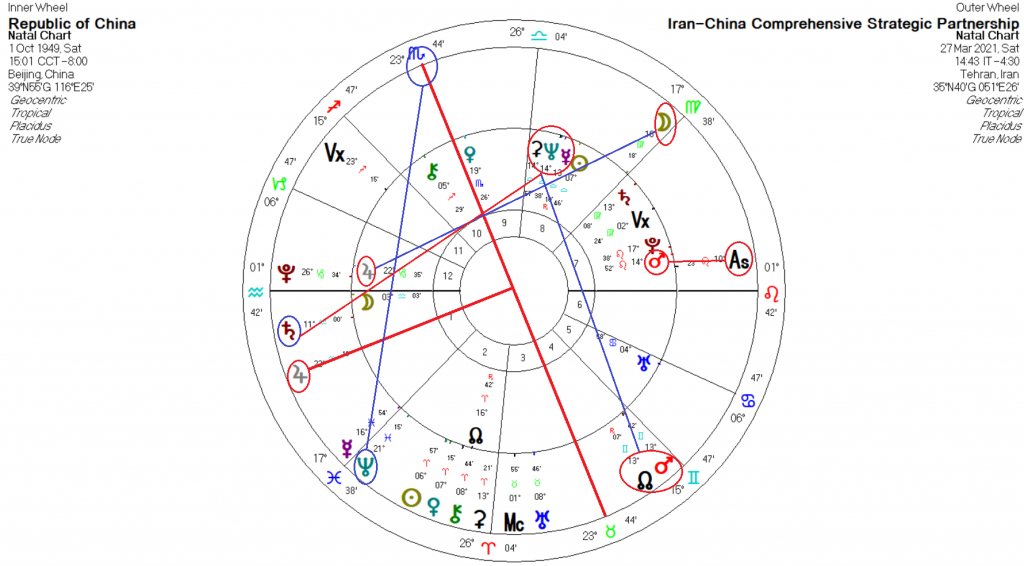
The first item apparent is the Jupiter-Meridian axis reversal between the Iran/agreement chart and those of China. The end result is the same, except in China’s case the agreement will serve to strengthen its footprint in the world as a valued partner and its infrastructure, too. The most visible dynamic in the synastry revolves around oil – the agreement Saturn is trine China’s Neptune (oil) guaranteeing steady supply, and the agreement Neptune is trine China’s MC and sextile the IC. Iran has plenty of oil and gas. The Agreement also goes to fulfill a dream or ideal of China’s – a major link and hub in its Belt and Road Initiative (BRI).
The CSPIC is a good example of a win-win contract, with both sides getting what they need, and the agreement helping both sides to grow in wealth. The CSPIC is also a security agreement for China, too, evidenced by the mutual Mars contacts between the CSPIC and China. Then, there is the synastry between Iran and China as nations. That bi-wheel is below (bigger):
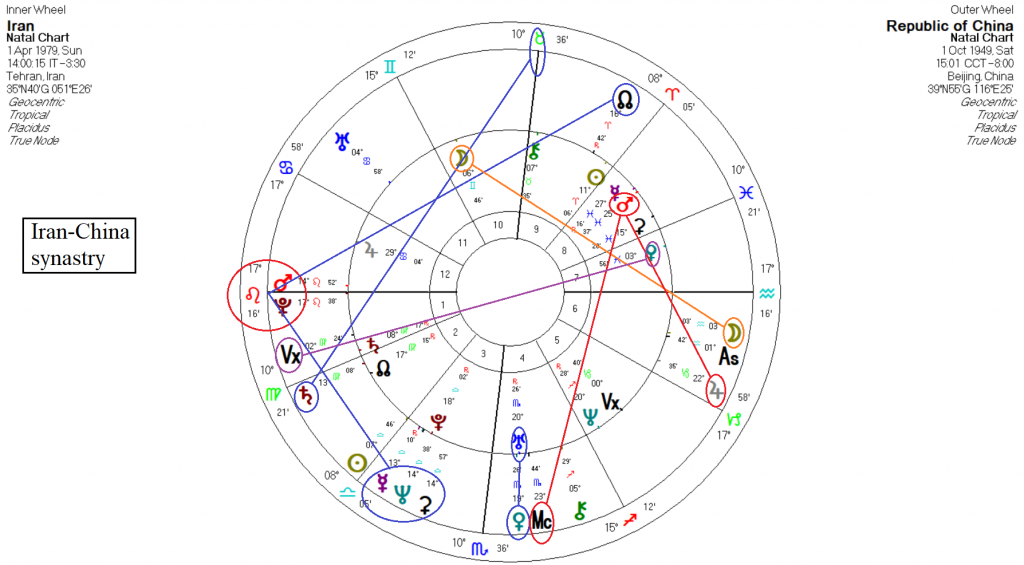
The immediate standout is China’s Mars/Pluto conjunction on Iran’s Ascendant. This gives Iran a fighting chance. Asc=Mars/Plu: “Daring and temerity, the desire to face danger. – An accident.” In ordinary synastry that combination can represent a potentially dangerous situation for the person with the Ascendant – a violent or overly controlling partner. However, it has to be read in relation to the rest of the synastry, too. The party with a strong Ascendant can utilize the strength represented by the Mars/Pluto party as a source of creative power, thus advancing both parties. Iran has abundant strength and creativity shown in its chart. The two Moons are trine, showing a deep, sympathetic understanding.
Iran has ancient historical connections with China via the old Silk Road and their relations have typically almost always been good. China’s MC and Jupiter both favorably aspect Iran’s Mars, giving a vigorous and helpful energy to the partnership, as well as increasing security. And China’s Saturn is trine Iran’s MC, bringing a much-needed stability and long-term help to Iran.
But all is not joy and happiness with the CSPIC having been signed, not in the Beltway, anyway. This partnership goes a way toward cementing Mackinder’s ‘Heartland’, but not in control of the West. The Heartland theory was always just a dream anyway. But to put it in perspective, the main nations at the center of control of that landmass are China, Russia and Iran, Iran being the linking nation. We are talking basically of Asia, with a population of about 4.5 billion people (60% of the world’s population) and 30% of the world’s landmass.
Asia also holds vast, untapped resources, mostly in Russia, and it has been a dream of the Western powers for many decades to control that area of the world. They had it almost within their grasp, too, until the Russian Federation slipped through their fingers. And that was due in large part to poor policy, a lack of statesmanship, underestimation of Vladimir Putin when the Western handlers vetted him to lead the Russian Federation, an unfounded sense of exceptionalism (a carryover from imperial conquests) and a true ignorance of Asian cultures on the part of Western elites. What will agreements like the CSPIC go on to produce, then? A map will explain much regarding that.
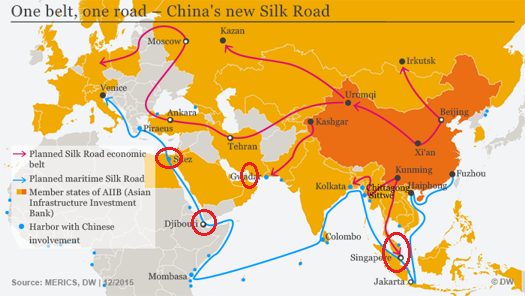
We note Iran is the main link from Urumqi in Xinjiang to Southern Europe via the Bosporus and onward to Moscow. This is the main overland link in China’s BRI project. That would bypass the Malacca Strait and cut transit time considerably for essential goods to Europe. It would also bypass the Suez Canal. Container ships may be cheaper at present, but the recent grounding of the Ever Given in the Suez has heightened concerns about shipping and has opened ideas for alternative transit routes. That grounding was a gift in disguise. In fact, there is much in the works with the BRI project, with the Ever Given incident bringing it forward:
Crucially, multiple BRI trade connectivity corridors are directly linked to establishing alternative routes to oil and gas transit, controlled or “supervised” by the Hegemon since 1945: Suez, Malacca, Hormuz, Bab al Mandeb.
Those straits are circled in red on the map, above. Control of these straits is seen as crucial for the US and the West to maintain, for ‘security purposes’ and energy supplies, and to stop overland alternatives – especially for the transport of oil and gas. This latter is why there is so much animosity toward Iran and China – Russia as well – by the United States. Now, what would happen if Iran were to sign a similar strategic partnership with Russia? Well, that is in the works, too. That would enable the completion of the proposed North-South transport corridor linking a port in Iran directly to Russia via either the Caspian Sea or Azerbaijan, bypassing the Suez and Bab al Mandeb straits completely (map). Such a transport corridor would all but quash plans for a canal from the Gulf of Aqaba to the Mediterranean, as an alternative to the Suez.
The signing of the CSPIC is of bigger moment than the Russian intervention in Syria in 2015. The agreement will fast track the following:
- Ending the threat of US and EU sanctions to Iran and China. That will lead to…
- Other nations coming on line with alternatives to the SWIFT system of international payment, thus ending the ability of the West to impose economic hardship on other nations via sanctions. In other words, sanctions will become ineffective as a form of warfare.
- It will weaken the power of the Saudis and will cause significant shifts in the geopolitics of the Middle East/West Asia.
- The nations of the region, seeing opportunities eastward and in solidarity, will begin to abandon their dependence on the West, notably American dollars and expensive American weapons. The collective West will eventually become simple trading partners instead of controlling entities.
- It will secure Central, South-Central and East Asia militarily for the most part, as Iran will soon be a full member of the SCO. When Azerbaijan finally joins, the ‘Heartland’ will be almost wholly under the umbrella of the SCO, excepting Mongolia.
These events will unfold over the next few years, barring a major war. And that is becoming less and less likely as each year passes. The West, led by Washington, may huff and bluster all it likes, but the fact that such an agreement as CSPIC has even come about shows the extent to which the West has lost influence in Asia. And when the overland routes and oil and gas pipelines come online, what then for Western control of Asia? The Western powers see this, which is why we see so much in the way of military posturing and heightened rhetoric, tensions and ‘soft warfare’, such as cyber-attacks like the recent one on the Natanz nuclear site in Iran.
And if you want to see some of the infrastructure that is in the works, have a look at the following:
- The Peace Pipeline and the proposed TAPI pipeline
- The North-South transport corridor, stretching from Mumbai to Moscow, via Iran. Russia and Iran are aggressively pursuing this now in light of the Suez incident.
- The Chongqing-Duisburg rail line, eventually converted to high-speed rail
- The Jebal Ali to Haifa rail line (proposed), which presupposes a resolution of the Palestinian situation, and which was a factor behind formal normalization of UAE-Israeli relations last year. These had been ongoing in secret since the turn of this century. China is making inroads there, too.
- The Trans-Caspian pipeline (TCP)
- The White Stream pipeline
- The Lapis Lazuli corridor
- The Five Nations railway project
- The PAKAFUZ railway
- The completion of the CPEC (China-Pakistan Economic Corridor)
- And into the future, not outside the realm of possibility, but also highly dependent on India’s decisions regarding the West, is the idea of a Caspian canal, connecting the Caspian Sea with either the Persian Gulf or the Gulf of Oman.
There is more, but we see the massive scope of possibilities such an agreement as the CSPIC unlocks. Iran is central to or on the periphery of all the preceding projects. Is it any wonder, then, why Israel and the US seek to bring Iran to heel, as well as China and Russia?
Because of the threat to US and Western dominance in world affairs the CSPIC illustrates, There are doubts that we will be seeing US troops leaving Afghanistan, Iraq or Syria any time soon. Biden has promised to have the troops out of Afghanistan by 9/11 this year, but Afghanistan is a key link in some of the projects above, shares upwards of a 1000 km border with Iran and borders China as well. It is also why we see Turkish belligerence in the region increasing, Turkey being a NATO member, and why we see the US so keen on wooing India into its orbit.
The door is closing quickly on Western dominance of world trade and finance, though. Nations in the EU smell the opportunity agreements like the CSPIR represent and are beginning to look Eastward – Italy, Greece, Germany and virtually all of Eastern Europe. All this is consistent with the transit of Uranus through Taurus, and there are still a few years of that transit remaining. The old financial order is being upended. Thus the possibility of conflict is thus very much increased. Western elites and vested interests will not go quietly into the sunset. The roller coaster ride is about to get very interesting.
Featured pic from Fars News

